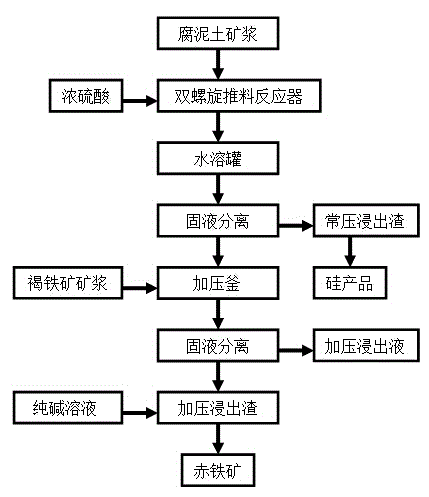Method for recovering nickel, cobalt, iron and silicon from laterite-nickel ore by combined leaching process
A laterite nickel ore and combined leaching technology, which is applied in the fields of iron, silicon, cobalt, and nickel recovery, can solve the problems of low nickel and cobalt leaching rates, high acid consumption, and poor economic benefits, and achieve high nickel and cobalt recovery rates, The effect of low acid consumption and fast recovery speed
- Summary
- Abstract
- Description
- Claims
- Application Information
AI Technical Summary
Problems solved by technology
Method used
Image
Examples
Embodiment 1
[0040] Take 500Kg 2 # Add 500Kg of water to saprolite ore (dry) to make saprolite slurry, prepare 500Kg of concentrated sulfuric acid with a mass fraction of 98%, heat the saprolite slurry to 60°C, and the concentrated sulfuric acid to 200°C, then use a mortar pump and a concentrated sulfuric acid pump to The heated saprolite slurry and concentrated sulfuric acid are simultaneously fed into the feed port of the twin-screw pusher reactor. After rapid mixing, the saprolite slurry and concentrated sulfuric acid are forced to flow into the double-screw pusher reactor for rapid reaction to dissolve soluble non-ferrous metals. and soluble iron, after reacting for 1 minute, push the reaction material out of the double-screw pusher reactor. Cool down to below 60°C, simply crush the reaction material of the loose honeycomb solid paste and pour it into a water immersion tank, add 1500Kg of water, stir for 30 minutes to dissolve in water, and pump the resulting slurry into a plate and fr...
Embodiment 2
[0054] Take 500Kg 5 # Add 600Kg of water to saprolite ore (dry) to make saprolite slurry, prepare 500Kg of concentrated sulfuric acid with a mass fraction of 98%, heat the saprolite slurry to 100°C, and the concentrated sulfuric acid to 150°C, then use a mortar pump and a concentrated sulfuric acid pump to The heated saprolite slurry and concentrated sulfuric acid are simultaneously fed into the feed port of the twin-screw pusher reactor. After rapid mixing, the saprolite slurry and concentrated sulfuric acid are forced to flow into the double-screw pusher reactor for rapid reaction to dissolve soluble non-ferrous metals. And soluble iron, after reacting for 12 minutes, push out the reaction material into the twin-screw pusher reactor. Cool down to below 60°C, simply crush the reaction material of the loose honeycomb solid paste and pour it into a water immersion tank, add 1920Kg of water, stir for 30 minutes to dissolve in water, and pump the resulting slurry into a plate and...
Embodiment 3
[0068] The normal-pressure acid leaching stage of the present embodiment is the same as that of Example 1, and in the pressure leaching stage, 1 # Sinka Limonite changed to 4 # Indonesian limonite.
[0069] Take 3000g 4 # Limonite (dry), add washing solution (E1) 6000ml to make limonite slurry, then move it into PARR4557 autoclave (17L), then add normal pressure leaching solution (B1) into the autoclave to make the final pH of the reaction material is 1.0, under pressure leaching for 60 minutes under the conditions of pressure 2.18MPa and temperature 215°C, Fe in normal pressure leach solution (B1) 3+ Hydrolyze to precipitate hematite and release acid and then leaching limonite; after cooling down to 80°C, remove the reaction slurry from the autoclave for solid-liquid separation and wash the filter residue to obtain 2800g of pressurized leaching residue (C3) (dry) , 7550ml of pressurized leaching solution (D3) and 4500ml of washing solution (F3), after removing non-nickel a...
PUM
| Property | Measurement | Unit |
|---|---|---|
| quality score | aaaaa | aaaaa |
Abstract
Description
Claims
Application Information
 Login to View More
Login to View More - R&D
- Intellectual Property
- Life Sciences
- Materials
- Tech Scout
- Unparalleled Data Quality
- Higher Quality Content
- 60% Fewer Hallucinations
Browse by: Latest US Patents, China's latest patents, Technical Efficacy Thesaurus, Application Domain, Technology Topic, Popular Technical Reports.
© 2025 PatSnap. All rights reserved.Legal|Privacy policy|Modern Slavery Act Transparency Statement|Sitemap|About US| Contact US: help@patsnap.com



